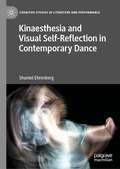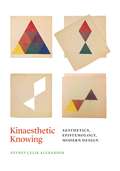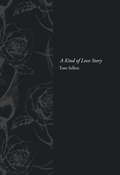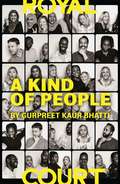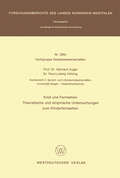- Table View
- List View
Kill Floor (Modern Plays)
by Abe KooglerSee in my opinion there are two types of people in the world.There are people who actually do something with their lives?Who have some kind of values or something?And then there are people like you.A small town. Today. Following a long incarceration, Andy returns to her hometown to restart her life. After securing a job at the local slaughterhouse, the challenges of reentry unfold as she reconnects with her teenage son, B, a staunch vegetarian with a life he's unwilling to share with his mother.Writer Abe Koogler has written a funny, surprising and moving search for connection in modern America. Kill Floor received its world premiere at New York's LCT3/Lincoln Center Theater in October 2015 and played at American Theatre Company, Chicago, from March 2016.
Killer Camera Rigs That You Can Build: How to Build Your Own Camera Cranes, Car Mounts, Stabilizers, Dollies, and More!
by Dan SelakovichThe singular beauty of this book is that Mr. Selakovich has successfully dedicated himself to producing clarity with every page." - Michael Ferris, Camera Operator/DP (Die Hard) For filmmakers who like to shoot their films with a mobile camera withough spending a fortune on equipment rentals, this book is a great gift indeed. I highly recommend it for its clarity and common sense." - Kris Malkiewica, Cinematographer/Author Don't buy or rent your fillm equipment-build it! Construct professional-quality camera rigs on your own with this comprehensive, step-by-step guide and stop wasting your money on overpriced equipment rentals and purchases! Dan Selakovich guides you through the creation of jibs, dollies, cranes, car-mounts, sandbags, tripods, and more. Features include: Build inexpensive but reliable and sturdy rigs-including cranes, dollies, stabilizers, car-mounts, and more; most for much less than $100!Includes over 2,000 photographs with clear step-by-step instructions, safety guidelines, material lists, and tool lists for each rig. American standard and meric measurements included. Includes a companion web site: http://dvcamerarigs.com/
Killer Camera Rigs That You Can Build: How to Build Your Own Camera Cranes, Car Mounts, Stabilizers, Dollies, and More!
by Dan SelakovichThe singular beauty of this book is that Mr. Selakovich has successfully dedicated himself to producing clarity with every page." - Michael Ferris, Camera Operator/DP (Die Hard) For filmmakers who like to shoot their films with a mobile camera withough spending a fortune on equipment rentals, this book is a great gift indeed. I highly recommend it for its clarity and common sense." - Kris Malkiewica, Cinematographer/Author Don't buy or rent your fillm equipment-build it! Construct professional-quality camera rigs on your own with this comprehensive, step-by-step guide and stop wasting your money on overpriced equipment rentals and purchases! Dan Selakovich guides you through the creation of jibs, dollies, cranes, car-mounts, sandbags, tripods, and more. Features include: Build inexpensive but reliable and sturdy rigs-including cranes, dollies, stabilizers, car-mounts, and more; most for much less than $100!Includes over 2,000 photographs with clear step-by-step instructions, safety guidelines, material lists, and tool lists for each rig. American standard and meric measurements included. Includes a companion web site: http://dvcamerarigs.com/
Killing Hercules: Deianira and the Politics of Domestic Violence, from Sophocles to the War on Terror
by Richard RowlandThis book offers an entirely new reception history of the myth of Hercules and his wife/killer Deianira. The book poses, and attempts to answer, two important and related questions. First, why have artists across two millennia felt compelled to revisit this particular myth to express anxieties about violence at both a global and domestic level? Secondly, from the moment that Sophocles disrupted a myth about the definitive exemplar of masculinity and martial prowess and turned it into a story about domestic abuse, through to a 2014 production of Handel’s Hercules that was set in the context of the ‘war on terror’, the reception history of this myth has been one of discontinuity and conflict; how and why does each culture reinvent this narrative to address its own concerns and discontents, and how does each generation speak to, qualify or annihilate the certainties of its predecessors in order to understand, contain or exonerate the aggression with which their governors – of state and of the household – so often enforce their authority, and the violence to which their nations, and their homes, are perennially vulnerable?
Killing Hercules: Deianira and the Politics of Domestic Violence, from Sophocles to the War on Terror
by Richard RowlandThis book offers an entirely new reception history of the myth of Hercules and his wife/killer Deianira. The book poses, and attempts to answer, two important and related questions. First, why have artists across two millennia felt compelled to revisit this particular myth to express anxieties about violence at both a global and domestic level? Secondly, from the moment that Sophocles disrupted a myth about the definitive exemplar of masculinity and martial prowess and turned it into a story about domestic abuse, through to a 2014 production of Handel’s Hercules that was set in the context of the ‘war on terror’, the reception history of this myth has been one of discontinuity and conflict; how and why does each culture reinvent this narrative to address its own concerns and discontents, and how does each generation speak to, qualify or annihilate the certainties of its predecessors in order to understand, contain or exonerate the aggression with which their governors – of state and of the household – so often enforce their authority, and the violence to which their nations, and their homes, are perennially vulnerable?
Killing Men & Dying Women: Imagining Difference in 1950s New York Painting
by Griselda PollockWhat did it mean for painter Lee Krasner to be an artist and a woman if, in the culture of 1950s New York, to be an artist was to be Jackson Pollock and to be a woman was to be Marilyn Monroe? With this question, Griselda Pollock begins a transdisciplinary journey across the gendered aesthetics and the politics of difference in New York abstract, gestural painting. Revisiting recent exhibitions of Abstract Expressionism that either marginalised the artist-women in the movement or focused solely on the excluded women, as well as exhibitions of women in abstraction, Pollock reveals how theories of embodiment, the gesture, hysteria and subjectivity can deepen our understanding of this moment in the history of painting co-created by women and men. Providing close readings of key paintings by Lee Krasner and re-thinking her own historic examination of images of Jackson Pollock and Helen Frankenthaler at work, Pollock builds a cultural bridge between the New York artist-women and their other, Marilyn Monroe, a creative actor whose physically anguished but sexually appropriated star body is presented as pathos formula of life energy.Monroe emerges as a haunting presence within this moment of New York modernism, eroding the policed boundaries between high and popular culture and explaining what we gain by re-thinking art with the richness of feminist thought.
Killing Men & Dying Women: Imagining Difference in 1950s New York Painting
by Griselda PollockWhat did it mean for painter Lee Krasner to be an artist and a woman if, in the culture of 1950s New York, to be an artist was to be Jackson Pollock and to be a woman was to be Marilyn Monroe? With this question, Griselda Pollock begins a transdisciplinary journey across the gendered aesthetics and the politics of difference in New York abstract, gestural painting. Revisiting recent exhibitions of Abstract Expressionism that either marginalised the artist-women in the movement or focused solely on the excluded women, as well as exhibitions of women in abstraction, Pollock reveals how theories of embodiment, the gesture, hysteria and subjectivity can deepen our understanding of this moment in the history of painting co-created by women and men. Providing close readings of key paintings by Lee Krasner and re-thinking her own historic examination of images of Jackson Pollock and Helen Frankenthaler at work, Pollock builds a cultural bridge between the New York artist-women and their other, Marilyn Monroe, a creative actor whose physically anguished but sexually appropriated star body is presented as pathos formula of life energy.Monroe emerges as a haunting presence within this moment of New York modernism, eroding the policed boundaries between high and popular culture and explaining what we gain by re-thinking art with the richness of feminist thought.
Kin
by E. V. CroweEverybody expects the report to say they are a delight. They are very bright. They are pure as light. But they are small dogs Headmistress. I must report what I see. They are small dogs in packs or pairs, doing what small dogs do.A girls' boarding school in the 1990s is no Malory Towers. Whilst Mimi learns her lines for John Proctor in the Christmas play, Janey desperately clings on to her best-friend status.
Kinaesthesia and Classical Antiquity 1750–1820: Moved by Stone (Bloomsbury Studies in Classical Reception)
by Helen SlaneyThis book argues that touch and movement played a significant role, long overlooked, in generating perceptions of ancient material culture in the late 18th century. At this time the reception of classical antiquity had been transformed. Interactions with material culture – ruins, sculpture, and artefacts – formed the core of this transformation. Some such interactions were proto-archaeological, such as the Dilettanti expeditions to Athens and Asa Minor; others were touristic, seen in the guidebooks consulted by travellers to Rome and the diaries they composed; and others creative, resulting in novels, poetry, and dance performances. Some involved the reproduction of experience in a gallery or museum setting. What all encounters with ancient material culture had in common, however, is their haptic sensory basis.The sense typically associated with the Enlightenment is vision, but this has obscured the equally important contribution made by touch and movement to the way in which a newly materialised Graeco-Roman world was perceived. Kinaesthesia, or the sense of self-movement, is rarely recognised in its own right, but because all encounters with sites and objects are embodied, and all embodiment takes place in motion, this sense is vital to forming more abstract or imaginative impressions. Theories of embodied cognition propose that all intellectual processes are also physical. This book shows how ideas about classical antiquity in the volatile milieu of the late 18th century developed as a result of diverse kinaesthetic relationships.
Kinaesthesia and Classical Antiquity 1750–1820: Moved by Stone (Bloomsbury Studies in Classical Reception)
by Helen SlaneyThis book argues that touch and movement played a significant role, long overlooked, in generating perceptions of ancient material culture in the late 18th century. At this time the reception of classical antiquity had been transformed. Interactions with material culture – ruins, sculpture, and artefacts – formed the core of this transformation. Some such interactions were proto-archaeological, such as the Dilettanti expeditions to Athens and Asa Minor; others were touristic, seen in the guidebooks consulted by travellers to Rome and the diaries they composed; and others creative, resulting in novels, poetry, and dance performances. Some involved the reproduction of experience in a gallery or museum setting. What all encounters with ancient material culture had in common, however, is their haptic sensory basis.The sense typically associated with the Enlightenment is vision, but this has obscured the equally important contribution made by touch and movement to the way in which a newly materialised Graeco-Roman world was perceived. Kinaesthesia, or the sense of self-movement, is rarely recognised in its own right, but because all encounters with sites and objects are embodied, and all embodiment takes place in motion, this sense is vital to forming more abstract or imaginative impressions. Theories of embodied cognition propose that all intellectual processes are also physical. This book shows how ideas about classical antiquity in the volatile milieu of the late 18th century developed as a result of diverse kinaesthetic relationships.
Kinaesthesia and Visual Self-Reflection in Contemporary Dance (Cognitive Studies in Literature and Performance)
by Shantel EhrenbergKinaesthesia and Visual Self-reflection in Contemporary Dance features interviews with UK-based professional-level contemporary, ballet, hip hop, and breaking dancers and cross-disciplinary explication of kinaesthesia and visual self-reflection discourses. Expanding on the concept of a ‘kinaesthetic mode of attention’ leads to discussion of some of the key values and practices which nurture and develop this mode in contemporary dance. Zooming in on entanglements with video self-images in dance practice provides further insights regarding kinaesthesia’s historicised polarisation with the visual. It thus provides opportunities to dwell on and reconsider reflections, opening up to a set of playful yet disruptive diffractions inherent in the process of becoming a contemporary dancer, particularly amongst an increasingly complex landscape of visual and theoretical technologies.
Kinaesthetic Knowing: Aesthetics, Epistemology, Modern Design
by Zeynep Çelik AlexanderIs all knowledge the product of thought? Or can the physical interactions of the body with the world produce reliable knowledge? In late-nineteenth-century Europe, scientists, artists, and other intellectuals theorized the latter as a new way of knowing, which Zeynep Çelik Alexander here dubs “kinaesthetic knowing.” In this book, Alexander offers the first major intellectual history of kinaesthetic knowing and its influence on the formation of modern art and architecture and especially modern design education. Focusing in particular on Germany and tracing the story up to the start of World War II, Alexander reveals the tension between intellectual meditation and immediate experience to be at the heart of the modern discourse of aesthetics, playing a major part in the artistic and teaching practices of numerous key figures of the period, including Heinrich Wölfflin, Hermann Obrist, August Endell, László Moholy-Nagy, and many others. Ultimately, she shows, kinaesthetic knowing did not become the foundation of the human sciences, as some of its advocates had hoped, but it did lay the groundwork—at such institutions as the Bauhaus—for modern art and architecture in the twentieth century.
Kinaesthetic Knowing: Aesthetics, Epistemology, Modern Design
by Zeynep Çelik AlexanderIs all knowledge the product of thought? Or can the physical interactions of the body with the world produce reliable knowledge? In late-nineteenth-century Europe, scientists, artists, and other intellectuals theorized the latter as a new way of knowing, which Zeynep Çelik Alexander here dubs “kinaesthetic knowing.” In this book, Alexander offers the first major intellectual history of kinaesthetic knowing and its influence on the formation of modern art and architecture and especially modern design education. Focusing in particular on Germany and tracing the story up to the start of World War II, Alexander reveals the tension between intellectual meditation and immediate experience to be at the heart of the modern discourse of aesthetics, playing a major part in the artistic and teaching practices of numerous key figures of the period, including Heinrich Wölfflin, Hermann Obrist, August Endell, László Moholy-Nagy, and many others. Ultimately, she shows, kinaesthetic knowing did not become the foundation of the human sciences, as some of its advocates had hoped, but it did lay the groundwork—at such institutions as the Bauhaus—for modern art and architecture in the twentieth century.
Kinaesthetic Knowing: Aesthetics, Epistemology, Modern Design
by Zeynep Çelik AlexanderIs all knowledge the product of thought? Or can the physical interactions of the body with the world produce reliable knowledge? In late-nineteenth-century Europe, scientists, artists, and other intellectuals theorized the latter as a new way of knowing, which Zeynep Çelik Alexander here dubs “kinaesthetic knowing.” In this book, Alexander offers the first major intellectual history of kinaesthetic knowing and its influence on the formation of modern art and architecture and especially modern design education. Focusing in particular on Germany and tracing the story up to the start of World War II, Alexander reveals the tension between intellectual meditation and immediate experience to be at the heart of the modern discourse of aesthetics, playing a major part in the artistic and teaching practices of numerous key figures of the period, including Heinrich Wölfflin, Hermann Obrist, August Endell, László Moholy-Nagy, and many others. Ultimately, she shows, kinaesthetic knowing did not become the foundation of the human sciences, as some of its advocates had hoped, but it did lay the groundwork—at such institutions as the Bauhaus—for modern art and architecture in the twentieth century.
Kinaesthetic Knowing: Aesthetics, Epistemology, Modern Design
by Zeynep Çelik AlexanderIs all knowledge the product of thought? Or can the physical interactions of the body with the world produce reliable knowledge? In late-nineteenth-century Europe, scientists, artists, and other intellectuals theorized the latter as a new way of knowing, which Zeynep Çelik Alexander here dubs “kinaesthetic knowing.” In this book, Alexander offers the first major intellectual history of kinaesthetic knowing and its influence on the formation of modern art and architecture and especially modern design education. Focusing in particular on Germany and tracing the story up to the start of World War II, Alexander reveals the tension between intellectual meditation and immediate experience to be at the heart of the modern discourse of aesthetics, playing a major part in the artistic and teaching practices of numerous key figures of the period, including Heinrich Wölfflin, Hermann Obrist, August Endell, László Moholy-Nagy, and many others. Ultimately, she shows, kinaesthetic knowing did not become the foundation of the human sciences, as some of its advocates had hoped, but it did lay the groundwork—at such institutions as the Bauhaus—for modern art and architecture in the twentieth century.
Kinästhetische Interferenzen: Körpertechnik und Tanznotation im Entwurfsprozess architektonischer Räume (Architekturen #65)
by Dominik MohsIn einer künstlerisch basierten Studie zwischen architektonischer Entwurfspraxis und Tanzwissenschaft untersucht Dominik Mohs die Wechselwirkungen von Raumgestaltung und kinästhetischer Wahrnehmung. Rudolph von Labans choreographisches Denken überführt er dafür in eine experimentelle Versuchsanordnung, in der er Raumbildungsprozesse und Antriebe von Bewegungsimprovisationen mit Methoden der Tanzwissenschaften und Motion Capturing analysiert. Tänzerische Bewegung, verstanden als Einfühlung in den Raum und Ausdrucksgeschehen leiblich zentrierter Wahrnehmung, wird damit zur Grundlage, um den von August Schmarsow eingeführten architektonischen Raumbegriff zu hinterfragen.
Kind Hearts and Coronets (BFI Film Classics)
by Michael NewtonIn 'Kind Hearts and Coronets' (1949), Louis Mazzini (Dennis Price) schemes and murders his way to a dukedom. This title looks into the turbulent personalities that formed the complex style of this film to unravel the fusion of cynicism, contempt, sparkling wit and philosophical curiosity.
Kind Hearts and Coronets (BFI Film Classics)
by Michael NewtonIn 'Kind Hearts and Coronets' (1949), Louis Mazzini (Dennis Price) schemes and murders his way to a dukedom. This title looks into the turbulent personalities that formed the complex style of this film to unravel the fusion of cynicism, contempt, sparkling wit and philosophical curiosity.
A Kind of Love Story
by Tom SellersThe story behind life in a world-renown Michelin-starred restaurant.Tom Sellers is a luminary of the British culinary scene. His Restaurant Story opened its doors in April 2013; its innovative literary-inspired menu, taking diners on 'a personal journey through food', has won him huge critical and public acclaim. Story was awarded its first Michelin star just five months after opening. This stunning book will be your chance to enter the visionary mind of one of the most original chefs of our time, and discover the truth behind the tales of his brilliant food.
A Kind of Magic: Making the Original Highlander
by Jonathan Melville’An engrossing read with plenty of on-set anecdotes and insight’ – Neil Smith, Total Film’A definitive history . . . which every fan should read’ – Scott Varnham, Starburst’Jonathan Melville has done it again with yet another deep dive into a cult classic. His ability to dig out the facts is truly admirable. I thought I knew all there was to know about Highlander, but A Kind of Magic proves just how wrong I was’ – Mike White, The Projection Booth PodcastThe story of an immortal Scottish warrior battling evil down through the centuries, Highlander fused a high-concept idea with the kinetic energy of a pop promo pioneer and Queen’s explosive soundtrack to become a cult classic.When two American producers took a chance on a college student’s script, they set in motion a chain of events involving an imploding British film studio, an experimental music video director still finding his filmmaking feet, a former James Bond with a spiralling salary, and the unexpected arrival of low-budget production company, Cannon Films.Author Jonathan Melville looks back at the creation of Highlander with the help of more than 60 cast and crew, including stars Christopher Lambert and Clancy Brown, as they talk candidly about the gruelling shoot that took them from the back alleys of London, to the far reaches of the Scottish Highlands, and onto the mean streets of 1980s New York City.With insights from Queen’s Brian May and Roger Taylor on the film’s iconic music, exclusive screenwriter commentary on unmade scripts, never-before-seen photos from private collections, and a glimpse into the promotional campaign that never was, if there can be only one book on Highlander then this is it!
A Kind of People (Oberon Modern Plays)
by Gurpreet Kaur Bhatti“In this country, you go as far as they let you.” Friday night and someone’s having a party. It seems like a laugh, but not everyone’s having fun. Gary and Nicky have been together since school. Gary’s going for a promotion so he can get his family out of their council flat and give Nicky everything she deserves. Anjum and Mo are used to aiming for the best. And doing whatever it takes to get it. Gary’s sister Karen is more interested in having a life than fighting for any cause. Mark is just…always there. And Victoria, Victoria wants to dance with somebody…
Kind und Fernsehen: Theoretische und empirische Untersuchung zum Kinderfernsehen (Forschungsberichte des Landes Nordrhein-Westfalen #2954)
by Gerhard AugstEiner der ersten öffentlichen Auftritte des neu gegründeten For schungsschwerpunktes 'Massenmedien und Kommunikation' an der GH Siegen war im Mai 1976 eine Vortrags- und Diskussionsveranstal tung, bei der der Kommunikationstheoretiker Horst Holzer (München) und der Kinderfilmautor Sven Severin (Wiesbaden) sprachen. Severin zeigte einen Film, den das ZDF als dritten Teil der Rappelkistensendung 'Kinder machen nicht alles kaputt' sonntags zuvor gesendet hatte. Die Meinungen prallten hart aufeinander, die Urteile über den Film schwankten von "völlig unzureichend" bis "großartig". Viele Diskussionsbei träge gingen dabei von Vermutungen über die Wirkung dieses Films auf Kinder und Erwachsene aus. Dies war der Punkt, an dem wir uns angesprochen fühlten. Ein Ur teil über die Güte des Films muß auch davon abhängen, ob die Kinder und auch die Erwachsenen, denn mit deren Hilfe rechnet das Rappelkistenteam,den Film inhaltlich verstehen, ob sie den Sinn und damit auch die Intentionen des Films begreifen, ob si~ bereit sind, die Intentionen, Handlungsanweisungen bzw. die nor mativen (präskriptiven) Aussagen des Films zu akzeptieren, so daß die Kinder in Zukunft danach handeln und die Erwachsenen ihre Kinder in Zukunft danach handeln lassen.
Kinder kuratieren Klee: Ein museologisches Pionierprojekt (Edition Museum #83)
by Martin Waldmeier Nina Zimmer Zentrum Paul Zentrum Paul KleeNeue Wege der kulturellen Teilhabe zu finden ist ein Hauptziel des Kuratierens. Doch was passiert, wenn Kinder in den Prozess des Ausstellungsmachens einbezogen werden? Das museologische Pionierprojekt »Kinder kuratieren Klee« probiert es aus: Von der Konzeption über die Werkauswahl bis hin zum öffentlichen Auftritt planen Kinder eine umfangreiche Ausstellung zu Paul Klee, einem der bedeutendsten Vertreter der Moderne. Die Beiträger*innen dokumentieren ihre Erfahrungen und die Methoden, die dieses vielfältige und ungewöhnliche Projekt möglich machen - und legen so beispielhaft Chancen und Herausforderungen des Kuratierens mit Kindern im Kontext des Kunstmuseums offen.
Kindergarten Architecture
by Mark DudekThis fully illustrated guide to the planning and design of pre-school facilities for children is supported by a broad range of case studies, drawn from around the world. Both new buildings and adapted premises are covered. Essays on social development and childcare put the projects in context. Based on extensive research, Kindergarten Architecture offers the designer a unique survey of the best designs in kindergarten architecture. Two new kindergarten buildings are added to the case study section and the author provides guidance on the practical implications of recent changes to pre-school education. Contains two new case studies, 1. Corning Child Development Centre, New York and 2. Bornehaven De Fire Arstider, Copenhagen.
Kindergarten Architecture
by Mark DudekThis fully illustrated guide to the planning and design of pre-school facilities for children is supported by a broad range of case studies, drawn from around the world. Both new buildings and adapted premises are covered. Essays on social development and childcare put the projects in context. Based on extensive research, Kindergarten Architecture offers the designer a unique survey of the best designs in kindergarten architecture. Two new kindergarten buildings are added to the case study section and the author provides guidance on the practical implications of recent changes to pre-school education. Contains two new case studies, 1. Corning Child Development Centre, New York and 2. Bornehaven De Fire Arstider, Copenhagen.







